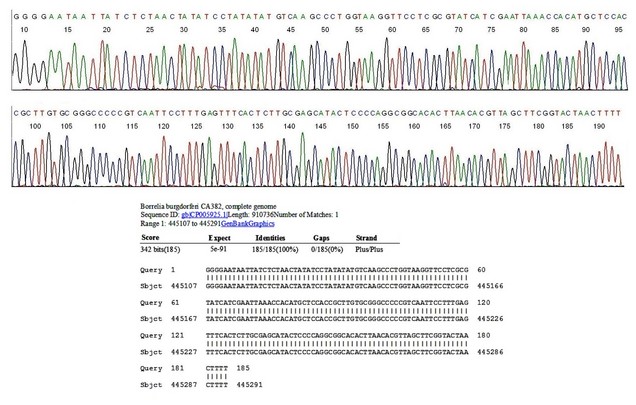http://www.dnalymetest.com/lymediseasediagnostics.html
Lyme Disease Diagnostics
Diagnostics Concerning the Identification of Tick-borne Diseases
Diseases caused by tick-borne pathogens in the United States include Lyme disease (more precisely Borrelia burgdorferi infection) and Lyme disease-like borrelioses ( such as Borrelia miyamotoi infection, Southern Tick-Associated Rash Illness and Borrelia hermsii infection), Babesiosis, Ehrlichiosis, Anaplasmosis, Rocky Mountain Spotted Fever, Tularemia, Colorado tick fever, Powassan encephalitis and Q fever. Some of these diseases, for example Babesiosis, Ehrlichiosis and Anaplasmosis, can be easily diagnosed by microscopic examination of a Wright-stained blood smear of the patient. A firm diagnosis of the others, especially for Lyme disease and Lyme disease-like borrelioses, the most common tick-borne disease group, may be difficult due to a lack of reliable laboratory tests.
The most effective means to control Lyme disease and Lyme disease-like borrelioses is the practice of personal protective measures against tick exposure. People living in or visiting a disease-endemic area are generally aware of the danger of tick bites. However, many individuals still contract Lyme disease or Lyme disease-like borrelioses in spite of taking all the personal protective measures.
Heightened awareness about tick-borne diseases by health care providers and the public has been achieved largely through intensified public health and Lyme disease specific educational programs, particularly in states with high rates of incidences. However, more often than not, the diagnosis of “Lyme disease," typical or atypical, rightly or wrongly, is patient-initiated. The medical practitioners in the health care front line know that if diagnosed early and reliably, the treatment with a proper course of antibiotics can “cure” the infection and effectively eliminate the “chronic phase” of the disease and avoid tissue damages.
However, the physicians have never had a reliable laboratory test for a conclusive diagnosis. This has left physicians unable to prescribe the proper treatment for the “cure” for many Lyme patients at the earliest, most advantageous time. This problem has become more complicated because it is now evident that there are Lyme disease-like borrelioses which do not have a set of typical diagnostic clinical manifestations and are antibody-negative when the patients are tested by the two-tier serology assays, the tests currently in use.
In the past 5 years, Dr. Sin Hang Lee and his associates have developed a nested PCR/DNA sequencing-based test for the infectious agents of Lyme disease and Lyme disease-like borrelioses, based on the technology published in 2010. The test offers a highly sensitive and reliable molecular diagnosis independent of clinical manifestations and serology test results. Before performing PCR amplification, the borrelial bacteria are concentrated by differential centrifugation from the blood and body fluids for DNA extraction to further increase the sensitivity of the detection method.

